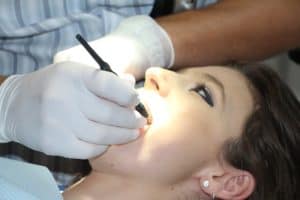Gingivitis – What You Need to Know
One of the most common yet elusive dental health problems is gingivitis. While gingivitis in itself is not particularly dangerous, letting it go untreated can result in some pretty severe dental health problems down the road. Keep reading to learn more about gingivitis, the symptoms, and how to treat it.
What is Gingivitis? Signs & Causes of Gingivitis
Gingivitis is a common oral health issue that affects thousands of people in the U.S. It’s characterized by gum inflammation, and patients who show signs of gingivitis may have red, swollen and sensitive gums. Other signs and symptoms of gingivitis include:
- Bleeding when flossing or brushing
- Receding gums
- Gum sensitivity and tenderness
- Bad breath that lingers even after brushing
Gingivitis is caused by an excess of plaque (an accumulation of bacteria) in the gums. Plaque is naturally formed by saliva, as well as a result of eating and drinking. Habits such as smoking, chewing tobacco, and consuming sugary drinks and foods can particularly contribute to plaque buildup.
While plaque is a normal occurrence, it becomes problematic when it sits too long in the mouth. An accumulation of plaque can irritate the gums, causing them to become red and swollen.
Other factors that can contribute to gingivitis include:
- Pregnancy
- Oral contraceptives
- Diabetes
- Chemotherapy
- Vigorous brushing with hard-bristled toothbrushes
If left untreated, gingivitis can cause periodontitis (gum disease). Periodontitis is a serious condition that can cause tooth loss and jawbone destruction. Therefore, if you show signs of gingivitis, you should address it promptly to prevent your condition from worsening.
How to Prevent Gingivitis
Establishing good brushing and flossing habits is the best way to reduce your chances of developing gingivitis. Brush your teeth twice a day and floss once a day as a baseline. You may also find it helpful to use antibacterial mouthwash, which can help eliminate bacterial buildup and give your mouth a blast of freshness.
Apart from building good dental hygiene habits, eating a balanced, healthy diet can help you avoid gingivitis. Eat a diet that is rich in whole foods, and avoid relying on sugary, processed snacks, beverages and candy.
How to Treat Gingivitis
Depending on the severity of your gingivitis, you may be able to treat it on your own. Simply staying consistent with daily brushing and flossing can reduce the amount of plaque and bacteria in your mouth. Use a toothpaste with tartar control for maximum health benefits, and make sure to change your toothbrush every three months or when the bristles become worn.
However, to really accelerate the gingivitis reversal process, you’ll want to pay a visit to your dental hygienist and dentist. He or she will perform a deep clean of your mouth, which will give you a sort of “fresh start” for establishing consistent flossing and brushing habits.
A Note About Flossing
We cannot overstate the importance of flossing. While brushing is equally important, flossing can remove plaque that cannot be reached with a brush. Many people overlook flossing entirely, yet doing so, even with healthy brushing habits, can contribute to gingivitis. Make flossing a part of your daily routine to ensure your teeth and gums stay as healthy as possible.
Think You Have Gingivitis? Contact Us Today
If you show any signs of gingivitis, such as bleeding gums or inflammation, contact us today to schedule a dentist appointment. We’ll be happy to help you get on track to a brighter and healthier smile.

